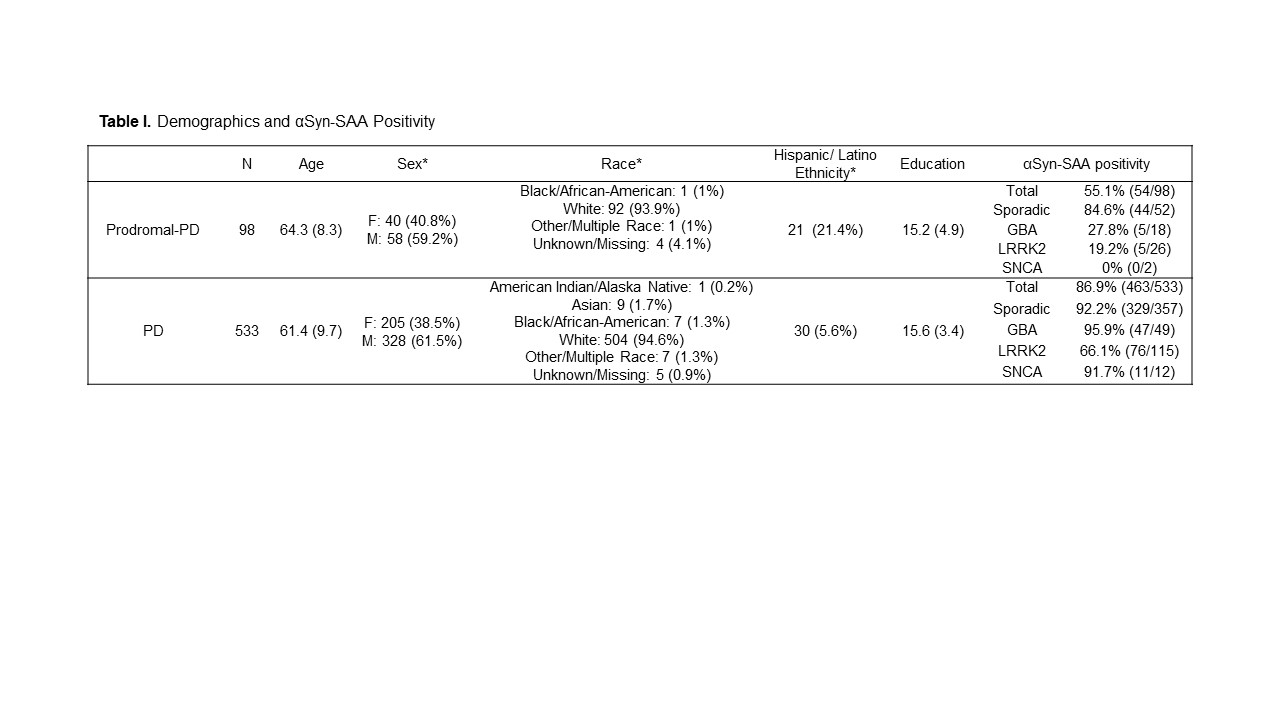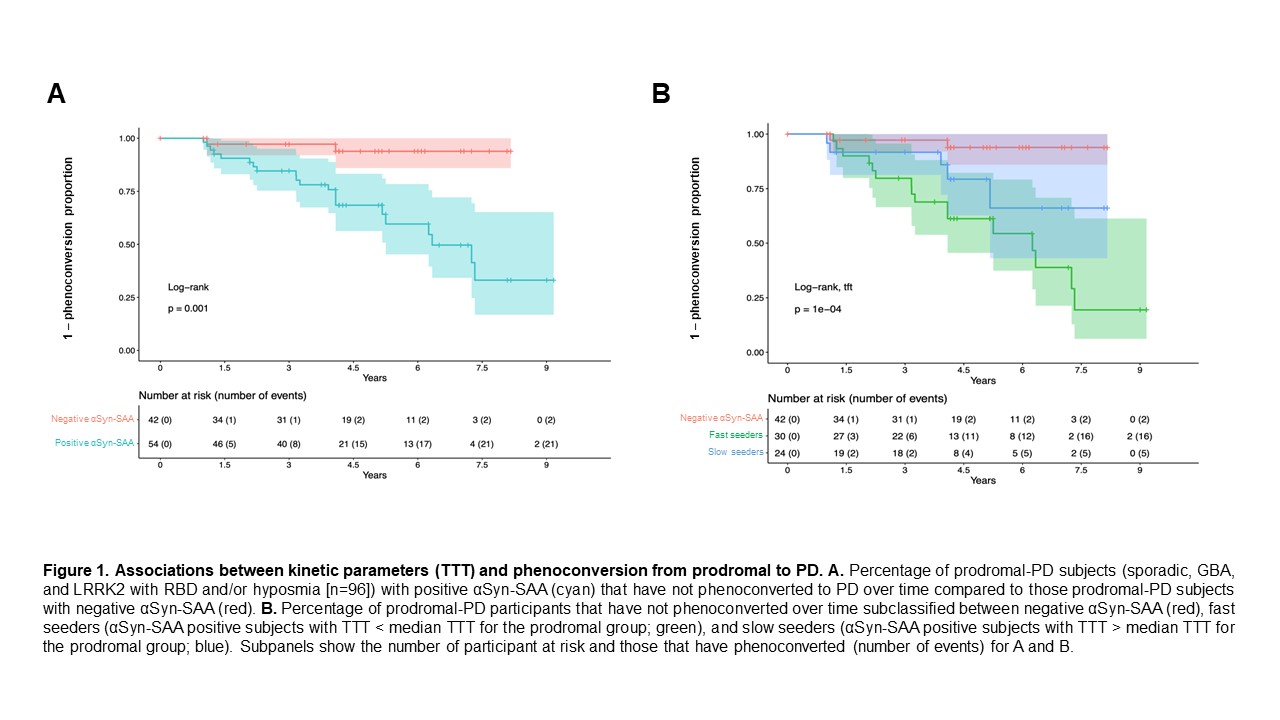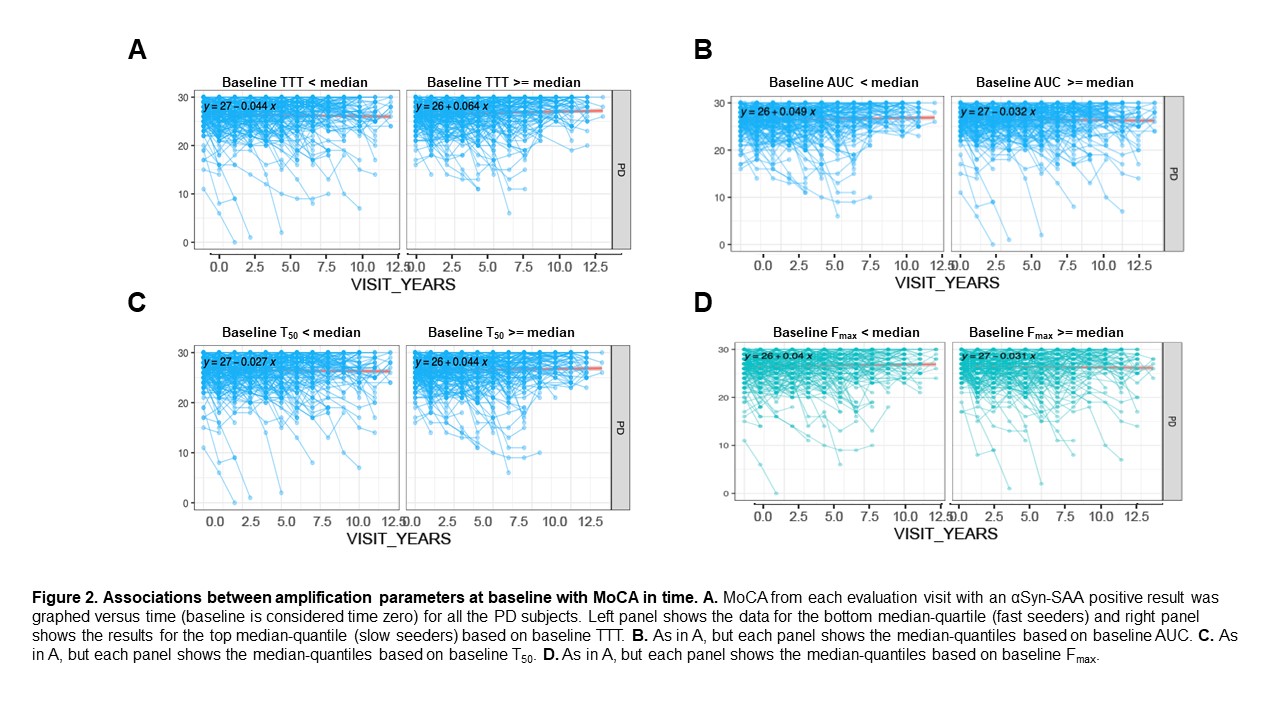Objective: To examine the relationship between the reaction parameters of the cerebrospinal fluid (CSF) αSyn seed amplification assay (αSyn-SAA) to the risk of developing motor parkinsonism in prodromal PD and with disease progression in manifest PD in participants from the PPMI study.
Background: αSyn-SAA enables qualitative detection of pathological αSyn seeds in CSF in PD as well as in prodromal states [1,2]. Early studies showed that higher masses of synthetic αSyn seeds had lower time-to-threshold (TTT, h), time to 50% maximum fluorescence (T50, h), and greater area under the curve (AUC, %*s), but did not change maximum fluorescence (Fmax, RFU). Here we compare the amplification parameters of αSyn-SAA tests to the risk of phenoconversion from prodromal-PD to manifest PD and to measures of clinical progression in PD.
Method: αSyn-SAA results from baseline CSF samples from 631 participants with consensus diagnoses (98 prodromal-PD, 533 PD) were analyzed using the Amprion research and development αSyn-SAA between February and August of 2022 [1]. Amplification parameters TTT, T50, Fmax, and AUC were calculated and compared to rates of phenoconversion and changes in MoCA scores and ‘off’ MDS-UPDRS part III scores in PD participants.
Results: While rates of αSyn-SAA positivity were higher among PD subjects that Prodromal-PD subjects (86.9% (463/533 versus 55.1% (54/98), p<0.0001), amplification parameters (T50, TTT, AUC, Fmax) were similar (p=0.5-0.9). Prodromal-PD subjects with positive αSyn-SAA tests had higher rates of phenoconversion to PD than those with negative αSyn-SAA tests (21/54 versus 2/42, Log-rank, p=0.001). Among the prodromal PD with positive αSyn-SAA, the 50% with lower TTT (“fast seeders”) presented increased phenoconversion in time compared to the other 50% of the subjects (“slow seeders”) (p<0.0001). Faster TTT and T50, and higher AUC values were associated with more rapid declines in MoCA scores in PD patients (p=0.001-0.02). No associations of kinetic parameters and change in MDS-UPDRS part III scores were observed.
Conclusion: αSyn-SAA positivity and faster seed amplification in at-risk individuals are associated with a greater probability of developing PD, although, this increased probability is not high enough to predict phenoconversion at the individual level.
Table 1: Demographics and aSyn-SAA positivity
Figure 1: Phenoconversion In Prodromal PD
Figure 2: MoCA Change Over Time in PD
References: 1. Siderowf A, Concha-Marambio L, Lafontant DE, Farris CM, Ma Y, Urenia PA, Nguyen H, Alcalay RN, Chahine LM, Foroud T, Galasko D. Assessment of heterogeneity among participants in the Parkinson’s Progression Markers Initiative cohort using α-synuclein seed amplification: a cross-sectional study. The Lancet Neurology. 2023 May 1;22(5):407-17.
2. Rossi M, Candelise N, Baiardi S, Capellari S, Giannini G, Orrù CD, Antelmi E, Mammana A, Hughson AG, Calandra-Buonaura G, Ladogana A. Ultrasensitive RT-QuIC assay with high sensitivity and specificity for Lewy body-associated synucleinopathies. Acta neuropathologica. 2020 Jul;140:49-62.
To cite this abstract in AMA style:
D. Coughlin, B. Shifflett, A. Siderowf, S. Edland, D. Galasko, C. Farris, Y. Ma, C. Soto, L. Concha-Marambio. α-Synuclein Seed Amplification Assay Amplification Parameters and Progression in Parkinson’s Disease [abstract]. Mov Disord. 2024; 39 (suppl 1). https://www.mdsabstracts.org/abstract/%ce%b1-synuclein-seed-amplification-assay-amplification-parameters-and-progression-in-parkinsons-disease/. Accessed April 24, 2025.« Back to 2024 International Congress
MDS Abstracts - https://www.mdsabstracts.org/abstract/%ce%b1-synuclein-seed-amplification-assay-amplification-parameters-and-progression-in-parkinsons-disease/



